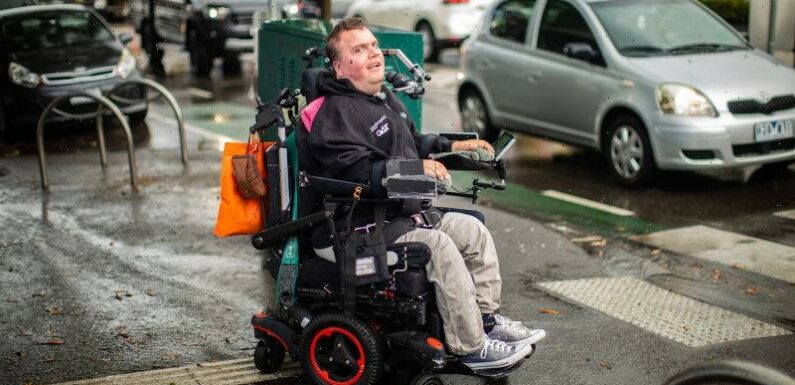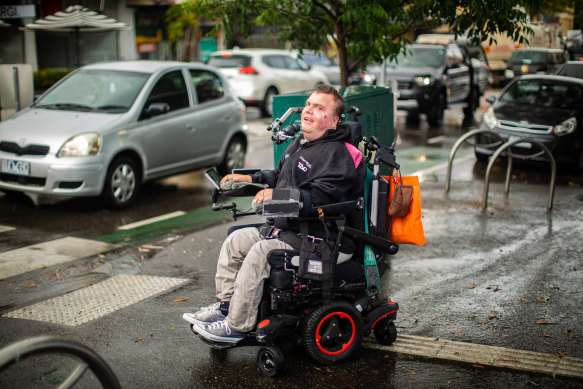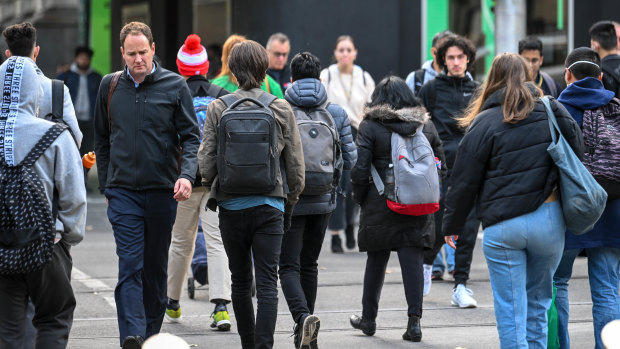
Anthony Bartl doesn’t remember the crash that nearly killed him and forever changed his life. But he knows one thing: the car that hit him in Kensington when he was six years old was going too fast.
“It’s all about speed, that’s a big part of the injury,” he says. “I was hit at 60km/h. If it was a 40km/h zone in Macaulay Road, I probably wouldn’t have had a C1 injury.”
Anthony Bartl says high speed limits in built-up areas are accidents waiting to happen. Credit:Scott McNaughton
C1 is the highest level of spinal injury. It left Bartl with quadriplegia, unable to move or feel below his neck or breathe without a ventilator, and requiring 24/7 care.
Macaulay Road is now a 40km/h zone and a pedestrian crossing has been built near where Bartl was hit, making it much safer than 36 years ago.
Still, 33 pedestrians have been killed in 2022, making it Melbourne’s deadliest year for pedestrians in more than a decade.
Bartl worries that high speed limits and poor infrastructure across the city mean many more accidents are “waiting to happen”.
“It’s just very frustrating because it’s such an easy fix, but nothing is being done,” he says. “All it would take is to say: this isn’t good enough, let’s do something about it.”
Melbourne has become far safer for motorists over the past two decades: driver and passenger deaths have fallen from an average of about 85 a year to just 34 so far in 2022. But pedestrian deaths have remained stubbornly high and the 33 killed this year is the highest number since 2011. Statewide, 45 have died.
Those killed while walking are likely to be older: people aged over 70 accounted for 227 of the 646 deaths in Melbourne since 2002.
Each of these deaths is “a completely unnecessary tragedy”, says Ingrid Johnston, chief executive of the Australasian College of Road Safety. “There is a lot more that we can and should be doing,” she says. “We absolutely do think right now that it’s just the price you pay … to be able to move from A to B. But it doesn’t have to be that way.”
Cities around the world are proving that. Oslo and Helsinki, cities with a combined population of 1.2 million, reduced pedestrian deaths to zero in 2019.
Johnston says better infrastructure is important for reducing deaths, but the key is lowering speed limits in areas where vehicles and people mix. “And that means bringing it down to 30 kilometres an hour,” she says.
A young adult has a 10 per cent chance of being killed if hit by a car at 30km/h. That jumps to 40 per cent at 40km/h and doubles to 80 per cent at 50km/h, research shows.
The World Health Organisation last year called on governments to adopt 30km/h in urban areas and cities including Paris, Brussels and Toronto are doing so, as is Spain nationwide. In Sydney, the suburbs of Manly and Liverpool have made the move, as have parts of Perth.
But Victoria Walks chief executive Ben Rossiter says local councils have a hard enough time getting Department of Transport approval to lower suburban streets from 50km/h to 40km/h.
He says overseas road safety experts “just go silent” when he tells them Victoria’s default urban speed limit is still 50km/h, and that many state government-controlled suburban arterial roads are 60km/h or higher.
“We haven’t made the walking environment safer,” Rossiter says. “We need to decide: do we want kids walking to school? Do we want a road environment that takes care of older pedestrians? Or will we continue to accept the high level of road violence?”
In Victoria, 30km/h can be applied only in “trials” and has been rolled out to parts of Collingwood and Fitzroy and the City of Whitehorse. There is another planned for Mildura next year.
The Department of Transport’s acting head of road safety, Marcelo Vidales, says the state has approved 27 new 40km/h zones since the start of 2022, including seven in school zones.
Road safety experts say pedestrian death rates won’t reduce without better infrastructure and lower speed limits. Credit:Eddie Jim
“When setting speed limits we need to carefully balance keeping everyone safe on our roads and keeping people moving around their communities,” Vidales says.
The City of Melbourne – where about 11 per cent of pedestrian crashes occur – says it hopes the state government will approve speed reductions in West and North Melbourne next year, the last of its suburbs not already 40km/h. The CBD’s “little streets” were reduced to 20km/h in 2020, but a council spokesman said it was not considering 30km/h zones beyond that.
Merri-bek City Council also hopes to have 40km/h limits across all of its streets next year, along with a 30km/h trial.
“The vast majority of places where we see multiple incidents involving pedestrians are intersections managed by the state government,” Merri-bek Mayor Angelica Panopoulos says.
Jennifer Oxley, a road safety expert at the Monash University Accident Research Centre, says factors including intoxicated pedestrians and the popularity of larger cars are contributing to pedestrian trauma, with walker distraction a potential issue too.
We can’t stop people making mistakes or eliminate crashes entirely, she says, meaning the focus needs to be on changing the outcome.
“So how can we separate pedestrians and vehicles and bring those speeds down, so in the event that there might be a collision, it won’t result in a serious injury?” Oxley says.
Any move to further slow cars will probably be met with backlash from some motorists. But Johnston says lower speeds often have a negligible effect on travel times, given vehicles are frequently stuck at traffic lights.
Bartl urges people to consider whether driving slightly faster is a worthy trade-off for the deaths and serious injuries that could be caused.
“It’s a bit ridiculous getting worked up over a few seconds – compare that to a whole lifetime of injury or a lifetime of disability,” he says.
He works with the road safety group Amber Community, talking to road offenders about how crashes affect people’s lives. His is a fulfilling one: he’s travelled overseas, scuba dived on the Great Barrier Reef, studied at university and last year started teaching at a primary school in Carlton North.
But he makes no bones about what he lost in that crash. “I’d give it all back if I could walk again and be independent,” he says.
The Morning Edition newsletter is our guide to the day’s most important and interesting stories, analysis and insights. Sign up here.
Most Viewed in National
From our partners
Source: Read Full Article

